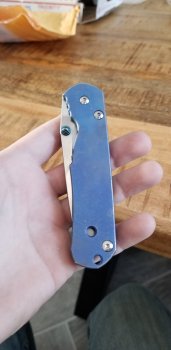Stang Bladeworks
KNIFE MAKER
I am just getting into anodizing titanium and i am wondering if etching a scale with the detent already set can affect it. I assume ceramic is fine but what about steel? Is it affected by multi etch or the actual anodizing process and if so what do you use to mask it off? I have heard that people use nail polish to make patterns so I assume that it should mask sufficiently.
I am in the process of building my own carbidizer and anodizer and I have a loaner knife coming in the mail to test the processes. I want to ensure that I do a good job on both.
Once I have everything figured out i plan to post a tutorial on building the unit with step by step instructions. I couldn't find a ton of info online so I hope it can help someone down the road.
Thanks in advance for your help.
I am in the process of building my own carbidizer and anodizer and I have a loaner knife coming in the mail to test the processes. I want to ensure that I do a good job on both.
Once I have everything figured out i plan to post a tutorial on building the unit with step by step instructions. I couldn't find a ton of info online so I hope it can help someone down the road.
Thanks in advance for your help.

